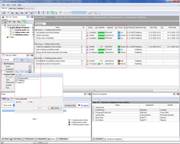 |
Task tracking is an important part of task management process that is aimed to review current progress of tasks and jobs, analyze whether this progress conforms to expectations, find imbalance in task performance, and collect information for further decision making. It entails retrospective reviews of pending and completed tasks and includes controlling and monitoring processes that result in developing and applying corrective actions to tasks. It is also the basis for analyzing tasks and creating reports. All information gathered during the process is accumulated in an electronic document which is called " log" or " form". This document is used to make decisions and find solutions to optimize performance. |
When you start monitoring tasks and jobs, there are several task parameters that you should review first of all in order to track tasks in an effective manner. Here are these parameters:
- Task priority and due date. These two parameters are basic for job monitoring, so they should be reviewed first of all. When tracking tasks, you can sort common task list by priority and due date to easily detect and review the most urgent and important tasks. In your log you can record tasks which are overdue and not performed in accordance with priorities.
- Task progress. The next record to be added in your form regards current progress of tasks. Taking into account due dates and priorities, you start the current progress of overdue and prioritized tasks. If the progress doesn’t conform to the expected one, you will need to develop a corrective action plan, which is considered later in this article. If the progress conforms to the expectations, you just pass to the next tasks, and so on. Appropriate records should be added in your form.
- Task assignment. Considering overdue tasks and their progress, you need to find out what employees are responsible for these tasks, so you will give these employees directions to do the tasks as quickly as possible.
The corrective action plan is a list of actions to be undertaken to correct a situation which is not favorable to you and which doesn’t meet your expectations. The plan usually contains standard actions to correct typical situations which are expected to occur on a regular basis. To develop the plan, you can use templates, including worksheets and spreadsheets. Such templates are usually used to create job logs that record long-term events (ex.:weekly logs).
At the same time, your corrective action plan may also include actions which you, as a manager, can undertake being guided by responsive decision making. This means that in a non-typical situation you need to make quick and reactive decisions to correct the situation. In such a case, agendas won’t be useful as they contain solutions for typical and long-term situations only. So you will need to use tools that give you flexibility in keeping and editing daily logs to record ongoing and non-typical events. |
VIP Task Manager is multi-user task management software that gives you powerful tools for work recording and logging. The software allows tracking tasks by priorities, due dates, progress and assignments. In Task List view of the software you can filter and sort tasks to get the most convenient task layout for tracking. As the software supports real time user collaboration, you can apply reactive decisions immediately after they have been made.
VIP Task Manager uses client-server technologies to allow you creating and managing databases in which you can keep task tracking templates, including job sheets and task tracking spreadsheets. You can edit and share templates with employees. The software logs history of task changes automatically, so you get a convenient way to create and use task tracking logs.
At this website you can find free spreadsheets, checklists and patterns. If you need to track tasks within projects, you can download project templates and agends from the website. |
|

